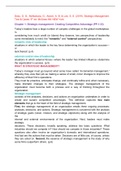Dess, G. G., McNamara, G., Aisner, A. B. & Lee, S. S. (2019). Strategic Management.
Text & Cases. 9th ed. McGraw-Hill: NEW York.
Chapter 1: Strategic management- Creating Competitive Advantage (PP.1-33)
Today’s leaders face a large number of complex challenges in the global marketplace.
In
considering how much credit (or blame) they deserve, two perspectives of leadership
come immediately to mind: the “romantic” and “external control” perspectives.
romantic view of leadership
situations in which the leader is the key force determining the organization’s success—
or
lack thereof. (p.4)
external control view of leadership
situations in which external forces—where the leader has limited influence—determine
the organization’s success. (p.5)
WHAT IS STRATEGIC MANAGEMENT?
Today’s manager must go beyond what some have called “incremental management,”
whereby they view their job as making a series of small, minor changes to improve the
efficiency of their firm’s operations.
They must be proactive, anticipate change, and continually refine and, when necessary,
make dramatic changes to their strategies. The strategic management of the
organization must become both a process and a way of thinking throughout the
organization.
Strategic management
consists of the analyses, decisions, and actions an organization undertakes in order to
create and sustain competitive advantages. This definition captures two main
elements that go to the heart of the field of strategic management.
First, the strategic management of an organization entails three ongoing processes:
analyses, decisions, and actions. Strategic management is concerned with the analysis
of strategic goals (vision, mission, and strategic objectives) along with the analysis of
the
internal and external environments of the organization. Next, leaders must make
strategic
decisions. These decisions, broadly speaking, address two basic questions: What
industries should we compete in? How should we compete in those industries? These
questions also often involve an organization’s domestic and international operations.
And last are the actions that must be taken. Decisions are of little use, of course, unless
they are acted on. Second, the essence of strategic management is the study of why
some firms outperform others. (p.6)
,operational effectiveness
performing similar activities better than rivals.
The Four Key Attributes of Strategic Management (p.7-8)
First, strategic management is directed toward overall organizational goals and
objectives. That is, effort must be directed at what is best for the total
organization, not just a single functional area. Some authors have referred to this
perspective as “organizational versus individual rationality.”
Second, strategic management includes multiple stakeholders in decision
making. Stakeholders are those individuals, groups, and organizations that have
a “stake” in the success of the organization, including owners (shareholders in a
publicly held corporation), employees, customers, suppliers, the community at
large, and so on.
Third, strategic management requires incorporating both short-term and long-
term perspectives. Peter Senge, a leading strategic management author, has
referred to this need as a “creative tension.”
Fourth, strategic management involves the recognition of trade-offs between
effectiveness and efficiency. Some authors have referred to this as the difference
between “doing the right thing” (effectiveness) and “doing things right”
(efficiency).
The tension between existing products and new ones, stability and change. This is the
innovation paradox. (p.8)
The concept of “ambidexterity” (similar to the aforementioned “innovation paradox”),
which refers to a manager’s challenge to both align resources to take advantage of
existing product markets and proactively explore new opportunities. (p.9)
THE STRATEGIC MANAGEMENT PROCES
three ongoing processes—analyses, decisions, and actions—that are central to
strategic management. these three processes—often referred to as strategy analysis,
strategy formulation, and strategy implementation—are highly interdependent and do
not take place one after the other in a sequential fashion in most companies.
intended strategy: strategy in which organizational decisions are determined only by
analysis.
realized strategy: strategy in which organizational decisions are determined by both
analysis and unforeseen environmental developments, unanticipated resource
constraints, and/or changes in managerial preferences. (p.10)
, strategy formulation: decisions made by firms regarding investments, commitments,
and other aspects of operations that create and sustain competitive advantage. (p.12)
is developed at several levels. First, business-level strategy addresses the issue of
how to compete in a given business to attain competitive advantage. Second,
corporate-level strategy focuses on two issues: (a) what businesses to compete in
and (b) how businesses can be managed to achieve synergy; that is, they create more
value by working together than by operating as standalone businesses. Third, a firm
must develop international strategies as it ventures beyond its national boundaries.
Fourth, managers must formulate effective entrepreneurial initiatives. (p.12)
strategy implementation: actions made by firms that carry out the formulated strategy,
including strategic controls, organizational design, and leadership. (p.13)
corporate governance: the relationship among various participants in determining the
direction and performance of corporations. The primary participants are (1) the
shareholders, (2) the management (led by the chief executive officer), and (3) the board
of directors. (p.16)
social responsibility: the expectation that businesses or individuals will strive to
improve the overall welfare of society. (p.19)
In order to maximize the positive impact of corporate social responsibility (CSR)
initiatives, firms need to create coherent strategies. Research has shown that
companies’ CSR activities are generally divided across three theaters of practice and
assigning the activities accordingly, is an important initial step.
Focusing on philanthropy
Improving operational effectiveness
Transforming the business model
triple bottom line: assessment of a firm’s financial, social, and environmental
performance. (p.20)
To develop and mobilize people and other assets, leaders are needed throughout the
organization. No longer can organizations be effective if the top “does the thinking” and





